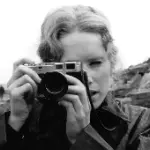For North American cinephiles who couldn’t make it to Cannes, it didn’t take long—just about a month after the festival ended—for the first film from the Competition lineup to hit theaters. And fittingly, it’s the kind of visual feast one can always count on from Wes Anderson. That feast, of course, stems from the director’s famously obsessive perfectionism. As expected, The Phoenician Scheme once again reflects his acute aesthetic compulsions—symmetrical framing, storybook color palettes, wide-angle compositions, and more.

By positioning key elements (people, objects, architecture, and space) dead center in the frame, Anderson’s signature penchant for symmetry creates a visual world that feels as if each frame were plucked from a blueprint, a children’s picture book, or a stage design. In The Phoenician Scheme, this style is taken to even greater extremes, thanks to its protagonists—Zsa-zsa Korda and his many rivals—all of whom are towering industry titans. From private jets to conference halls, Anderson pushes his symmetrical aesthetics to the limit, using perfectly arranged compositions as a philosophical framework for exploring emotion, power, and the threat of collapse. At the same time, the film reads like a self-deconstruction of his own compulsions: everything within his rigorously symmetrical universe appears orderly, yet it feels absurd, oppressive, and quietly unsettling.
Compared with Anderson’s earlier works like Asteroid City or The French Dispatch, which juggled multiple characters, narrative strands, and even timelines, The Phoenician Scheme is unusually viewer-friendly. With a clear, linear mission and a tightly focused emotional core, it recalls the relatively straightforward and entertaining tone of The Grand Budapest Hotel.
The main plot centers on industrial tycoon Zsa-zsa Korda (played by Benicio del Toro), who launches an enormous Phoenician infrastructure project via modern-day slave labor. In a bid to curtail his unethical business practices, the government hikes up the price of building materials, forcing Korda to scramble for new partners to plug what is quickly becoming a massive financial deficit. Thus begins a whirlwind of back-to-back investor meetings and Machiavellian negotiations—structured like a level-based single-player video game, complete with progress updates shown onscreen via intertitles quantifying how close he is to balancing the budget.
Threaded through this corporate quest is the film’s emotional backbone: a father-daughter relationship. Korda attempts to mend ties with his only daughter, Liesl (played by Mia Threapleton), who has become a devout nun. He forcibly pulls her out of the convent, hoping to groom her as his successor. Accompanying them on this high-stakes journey to salvage the business is Bjørn (played by Michael Cera), Korda’s executive assistant and a Norwegian entomologist. Facing bankruptcy, a crisis of faith, and long-buried secrets respectively, the trio form a curious ensemble. Each is crafted with the distinct character eccentricities typical of Anderson, and over the course of the story, they all undergo a subtle but compelling transformation.

The supporting cast, featuring a glittering lineup of stars including Tom Hanks, Mathieu Amalric, Scarlett Johansson, and Benedict Cumberbatch, serves not only as narrative milestones in Korda’s corporate quest, but also as aesthetic chess pieces in Anderson’s grand visual scheme. Each is carefully positioned to become part of his elaborate symmetrical tableaux—distinctive, striking, and always pleasing to the eye.
Every character, whether lead or supporting, feels like a carefully curated art piece arranged in Anderson’s own living room. This visual precision reminds me of an exhibition I once saw at the Kunsthistorisches Museum in Vienna: Spitzmaus Mummy in a Coffin and Other Treasures. In a glass vitrine mounted at eye level in a deep red room, centuries-old sculptures from the Habsburg dynasty were evenly spaced in a horizontal line, with the tallest positioned at the center and the heights tapering toward both ends to form a symmetrical wave. Beneath them, a row of pocket-watch miniatures followed the same symmetrical pattern—with the largest at the center and the sizes decreasing toward both sides. I took a photo of the displays, and it instantly brought to mind a scene from Bottle Rocket, where two slightly unhinged amateur thieves burglarize their own parents’ house. One of them pauses in front of a toy army he played with in his childhood, notices a toy soldier turned slightly askew, and instinctively straightens it before climbing out of the window.
As it turns out, the curator of that Vienna exhibition was none other than Anderson himself. The entire show was installed across eight interconnected rooms, each painted in a different background color. In a deliberate rejection of traditional museum practice, none of the objects bore labels—no names, no dates, and no information about the artists—so as not to disturb the aesthetic impact of the visual arrangement. The exhibition wasn’t merely a case of rummaging through overlooked corners of the museum’s collection. It involved restoring, transporting, and loaning the exhibits, as well as custom-building display cases—all of which required significant funding. The financial backing came from Fondazione Prada, which is Anderson’s longtime friend and patron.

Since the turn of the 21st century, Anderson’s films have grown steadily in popularity, and his singular aesthetic has increasingly captured the attention of art institutions and major brands alike. Fondazione Prada, for example, once invited Anderson to design the café on the ground floor of its Milan headquarters—a whimsical pink space that looks as if it were lifted straight from The Grand Budapest Hotel. In short, when visual style is taken to such obsessive extremes, it’s perhaps inevitable that some generous patron will foot the bill for the filmmaker’s compulsions.
In The Phoenician Scheme, several authentic and historically significant paintings are used as props. These include Pierre-Auguste Renoir’s Boy in a Blue Robe, once owned by the late actress Greta Garbo; René Magritte’s The Equator, held by the National Museums in Berlin (Staatliche Museen zu Berlin); and a number of treasured works from Hamburger Kunsthalle in Hamburg. Their inclusion was made possible through the industry connections and careful selections of veteran art curator Jasper Sharp. But it also speaks to the trust these institutions place in Anderson’s films—they believe this latest work would serve as a mobile artwork that aligns with their own curatorial sensibilities, and thus it’s a worthy vehicle for public exposure.
Of course, while original pieces by Renoir and Magritte remain under copyright protection, many 17th- and 18th-century Flemish masterworks have entered the public domain, making them easier to borrow or reproduce. Still, some artworks—such as those by Peter Paul Rubens or Wassily Kandinsky—are simply too valuable to risk. Their appearances in the film, therefore, are rendered via meticulously crafted replicas.






























































View replies 1